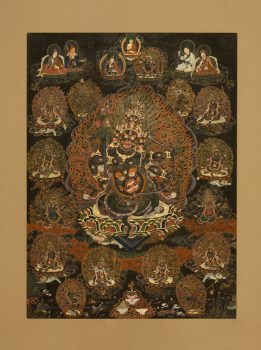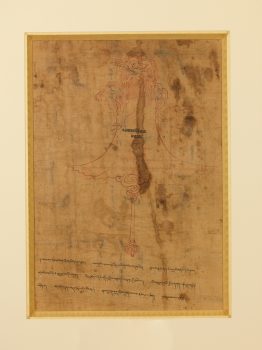Kham Province, Eastern Tibet
19th century


Kham Province, Eastern Tibet
19th century


FRONTRahula, shown at the center of a fifteen deity assembly, is a wrathful protector of the “revealed treasure” (terma) tradition of the Nyingma School, which was eventually practiced in other Tibetan Buddhist traditions as well. The upper area of the painting illustrates the teaching’s transmission. At the top center is a triad of Buddha Shakyamuni, Padmasambhava, and Vajrapani, the source of the practice focused on Rahula depicted in this painting. The four teachers flanking the triad are, from left to right, the treasure revealers Padma Ledreltsel (b. 1248), Gya Zhangdrom, Ngagi Wangpo (1580–1639), and the Tenth Situ, Padma Kunzang (1854–1885).BACKOn the painting’s reverse a victory banner topped by a sea monster (makara), the main attribute of the central deity depicted on the front, stands in for that deity, certainly a rare instance. In the center of it, mantras dedicated to Rahula are repeated in Lantsa script and in a Tibetan transliteration. The two longer lines in red ink include a prayer to the deity. The longer text at the bottom directly associates the deity with the tamer of spirits, Padmasambhava, who bound Rahula by oath to protect Buddhism. The text further extolls the beneficial powers of “this support for offering and contemplation.”
A religious movement that originated in India around the fifth to seventh century with sacred writings and esoteric teachings and practices transmitted from teacher to student through initiation. These remain an important part of Hinduism and Buddhism today.
A meditation technique primarily used in tantric practice that involves imagining a deity in one’s mind or imagining oneself becoming a deity and carrying out various activities. Such techniques are intended to help a practitioner transform ordinary perception and achieve enlightened qualities.
The transmission of teachings from one generation to the next, from teacher to student, traced all the way back to the Buddha without interruption. A complete lineage is essential in Tantric Buddhist practices as it makes the blessings of the teaching more powerful.
Protectors of Buddhist teachings who destroy obstacles that impede the path to enlightenment. The more frightening and gruesome their appearance, the greater their power.
Today, Tibetans primarily inhabit the Tibetan Plateau, situated between the Himalayan mountain range and the Indian subcontinent to the west, Chinese cultural regions to the east, and Mongolian cultural regions to the northeast. During the 7th to 9th century, Tibetan rulers expanded their empire across Central Asia, and established Buddhism as the state religion.
Get the latest news and stories from the Rubin, plus occasional information on how to support our work.